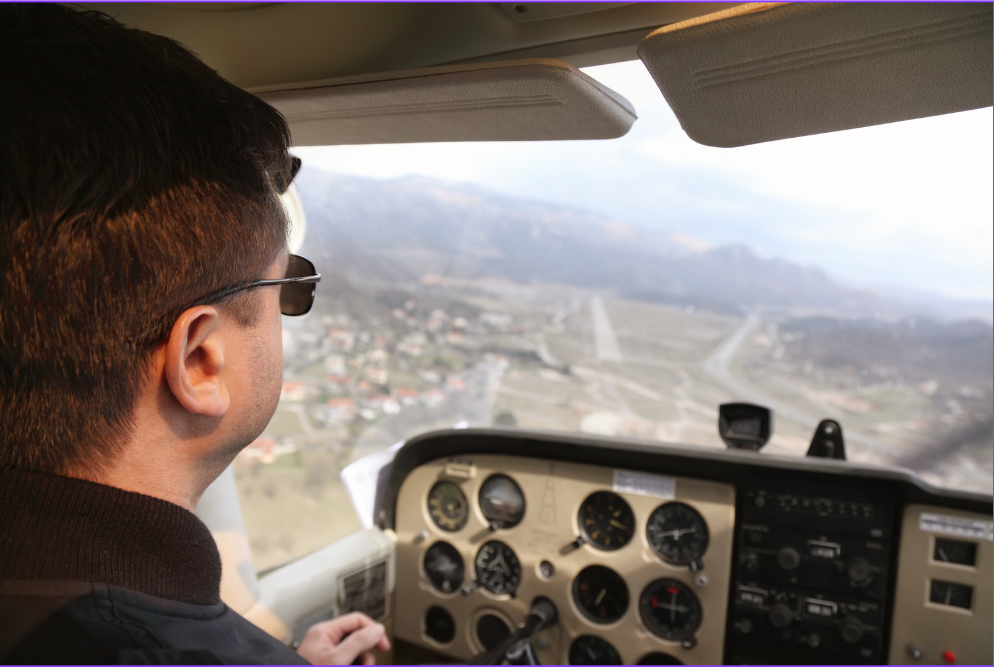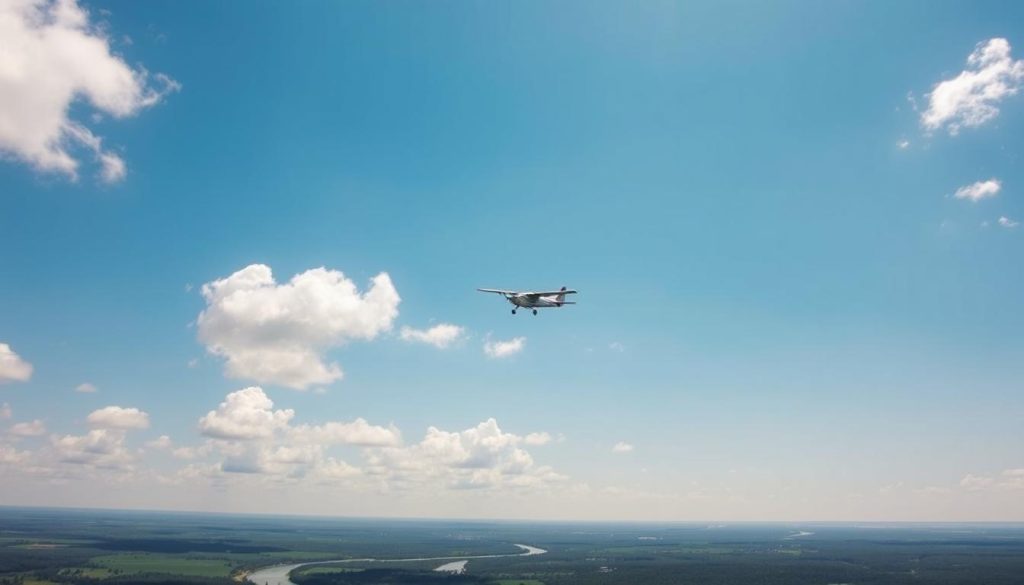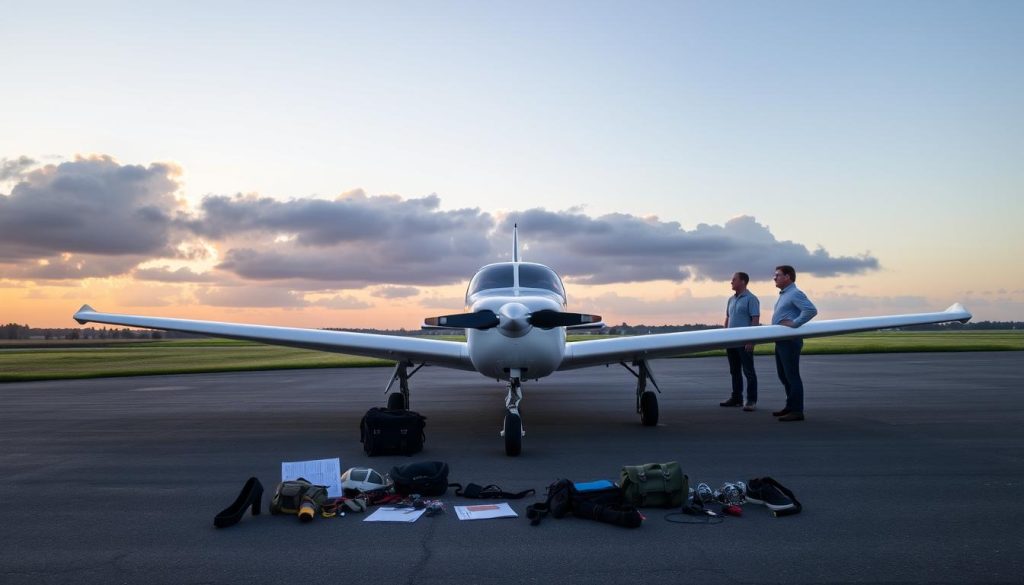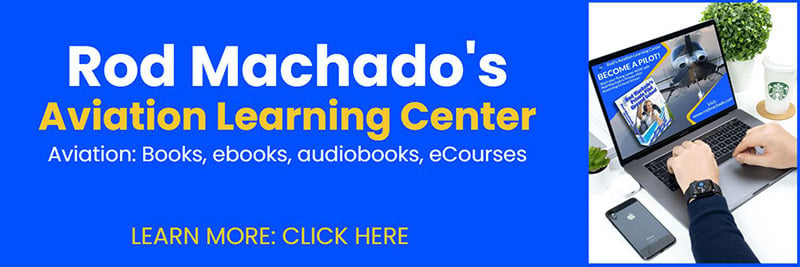Original publication date: October 23, 2024
Last Updated: 1 week
Author: Max Skyler
Topic: Flight Training
Number of Comments: 0
The day you go for your first solo as a student pilot is perhaps amongst the most exhilarating and adrenaline-rushing days of not your flight training, but I would dare say, of your entire life.
It is a pivotal milestone in every aspiring pilot’s life. Your flight instructor’s solo endorsement signifies your achievement: Becoming worthy of being endowed with the privilege of being able to take the controls of an aircraft as Pilot-in-Command.
Two Key Questions:
- How does your flight instructor know that you are ready for your first solo?
- What do you need to do, as a student pilot, to demonstrate that you are ready for your first solo?
Key Takeaways
- Understanding the significance of the solo flight as a benchmark in pilot training.
- Recognizing the extensive pre-solo preparation needed to meet FAA standards.
- Grasping the importance of flight school achievements leading up to a solo flight.
- Realizing that aviation training readiness goes beyond logged hours into mental and physical competency.
- Appreciating the safety protocols and instructor sign-off that ensure a fulfilling and secure solo flight experience.

What are the core prerequisites in order to be cleared for solo flight?
The FAA clearly lays out the requirements that all student pilots must meet prior to their flight instructor being authorized to endorse you for your first solo flight, in 14 CFR 61.87 of the Federal Aviation Regulations.
They can be broken down into the following main categories:
| Requirement Title | Description | FAA Reference |
|---|---|---|
| Aeronautical Knowledge | Must pass a test covering regulations, airspace, flight characteristics, and procedures for the aircraft. Incorrect answers reviewed with the instructor. | § 61.87(b) |
| Pre-Solo Flight Training | Complete and log specific flight training in the make and model of aircraft, under instructor supervision, demonstrating proficiency. | § 61.87(c) |
| Proficiency in Maneuvers | Must demonstrate proficiency in flight maneuvers, such as takeoffs, landings, stalls, and emergency procedures. | § 61.87(d) |
| Instructor Endorsement | Instructor must provide an endorsement in the student’s logbook for the specific aircraft, valid for up to 90 days. | § 61.87(n) |
| Night Solo Endorsement (if applicable) | Must receive additional training and an endorsement for night solo flights if conducted. | § 61.87(o) |
| Medical Certificate | Before solo flight, the student pilot must successfully obtain at least a third-class medical certificate, which verifies medical fitness for flying. | § 61.23(a)(3)(i) |
For more detailed information, please refer to the official FAA regulations on the eCFR website.
What are the maneuvers that student pilots must master prior to their first solo flight?
There are 15 total flight maneuvers that student pilots must master prior to being considered for solo flight endorsement by their instructor:
The table below provides a summary of each of them, as per FAR 14 CFR 61.87(d):
| Maneuver Title | Detailed Description | FAA Reference |
|---|---|---|
| Flight Preparation Procedures | Preflight planning, powerplant operation, and systems knowledge must be demonstrated. | § 61.87(d)(1) |
| Taxiing or Surface Operations | Perform taxiing, including runup procedures, with proper control of the aircraft on the ground. | § 61.87(d)(2) |
| Takeoffs and Landings | Execute normal and crosswind takeoffs and landings using appropriate techniques for conditions. | § 61.87(d)(3) |
| Straight and Level Flight and Turns | Maintain straight and level flight, perform turns in both directions while controlling altitude and airspeed. | § 61.87(d)(4) |
| Climbs and Climbing Turns | Perform climbs and climbing turns while maintaining speed, pitch, and coordination. | § 61.87(d)(5) |
| Airport Traffic Patterns | Follow standard traffic patterns for entering and departing the airport traffic area safely. | § 61.87(d)(6) |
| Collision and Hazard Avoidance | Apply techniques for avoiding midair collisions, windshear, and wake turbulence during all flight phases. | § 61.87(d)(7) |
| Descents with Turns | Perform descents, both straight and with turns, using various configurations to control airspeed and rate of descent. | § 61.87(d)(8) |
| Flight at Various Airspeeds | Control the aircraft at different airspeeds, ranging from cruise to slow flight, demonstrating transitions between them. | § 61.87(d)(9) |
| Stall Entry and Recovery | Perform stall entries from different attitudes and power settings, recovering at the first sign of a stall and from a full stall. | § 61.87(d)(10) |
| Emergency Procedures | Demonstrate correct emergency procedures, including handling equipment malfunctions and system failures. | § 61.87(d)(11) |
| Ground Reference Maneuvers | Execute maneuvers such as turns around a point and rectangular courses while maintaining proper ground track and wind correction. | § 61.87(d)(12) |
| Simulated Engine Malfunctions | Conduct approaches to a landing area, simulating an engine failure, while selecting and flying to a safe landing site. | § 61.87(d)(13) |
| Slips to a Landing | Perform forward slips or side slips to lose altitude while maintaining control for a safe landing. | § 61.87(d)(14) |
| Go-Arounds | Demonstrate go-arounds when a safe landing cannot be executed, transitioning to climb and maintaining airspeed and control. | § 61.87(d)(15) |
Check out this resource for a deeper dive into these 15 flight maneuvers.
What factors can influence the timeline for your solo flight readiness?
https://www.youtube.com/watch?v=EyEhJ4vUfuo
Starting your journey to become a pilot requires several key steps. Each step impacts your solo flight preparation timeline. It’s essential for aspiring pilots to understand these elements to navigate their training effectively.
Proficiency Level
Proficiency level is the single most important factor in determining when a student is ready to begin solo flight training.
This goes beyond just the number of hours logged; it focuses on a student’s ability to control the aircraft consistently and safely.
Proficiency includes mastering the key skills listed in the table above. It also involves the ability to make sound decisions under pressure. Every student learns at their own pace, so proficiency can be reached after a few hours of training for some, while others may need more time to build the required skill set. Instructors look for a combination of technical competence and situational awareness before allowing solo flight.
Frequency of Training
The frequency and consistency of a student pilot’s lessons directly impact the time it takes to prepare for solo flight.
Students who fly regularly, say multiple times per week, tend to progress faster because their skills are reinforced consistently.
On the other hand, students with gaps in their training—whether due to weather, personal schedules, or financial constraints—may require more time to reach the solo milestone, due to the need for repetition and review.
A steady and frequent schedule helps build muscle memory, confidence, and a deeper understanding of flight operations, all of which are crucial for soloing. Consistent flying also reduces the need for repetitive review, allowing students to advance more quickly through the training syllabus.
Weather Conditions
Weather conditions play a crucial role in determining when a student pilot can begin solo flight training, and they can significantly affect the overall training timeline.
For solo flight, students are required to fly under Visual Flight Rules (VFR) conditions, which are FAA-defined thresholds of visibility and cloud clearance. If weather conditions fall below these minimum due to factors such as fog, low clouds, or reduced visibility, the student pilot cannot legally or safely fly.
While this ensures the safety of inexperienced pilots, frequent poor weather can delay training. Too many days of non-VFR conditions, such as excessive wind, turbulence, rain, or snow, can result in gaps between lessons. These interruptions can slow a student’s progress by preventing consistent practice, which is essential for skill retention and building confidence.
When weather conditions are unsuitable, students must wait until the weather clears, often leading to extended periods of inactivity. This can happen especially during extended periods of rain or snow. Long gaps between lessons mean that the student may need to review or relearn skills they’ve already covered, prolonging the overall timeline for reaching solo readiness.
Additionally, challenging conditions such as high winds or turbulence, while sometimes useful for advanced training, are typically unsuitable for novice solo flights. Instructors will often postpone solo training on days where weather poses an added risk, ensuring that the student’s first experience flying alone occurs in the safest possible environment.
Ultimately, weather is one of the most unpredictable factors in flight training, and it requires students to be patient and flexible. It also underscores the importance of developing good aeronautical decision-making skills, as pilots must assess weather reports and make informed judgments about whether to fly or postpone.
Flight Instructor’s Availability
An instructor’s availability is a critical factor that can influence the timeline for a student’s solo flight.
Flight instructors often have busy schedules, especially at popular flight schools where they may be juggling multiple students.
Finding consistent training slots can be a challenge, particularly if your instructor has limited availability or if you have scheduling conflicts.
Delays in booking lessons can slow your progress, as regular practice is essential for skill retention and building confidence.
Additionally, if an instructor is unavailable for an extended period due to vacation, illness, or other commitments, students may experience significant gaps between lessons, leading to a prolonged training process.
To mitigate this, it’s crucial to work closely with your instructor to secure a consistent lesson schedule, ensuring you maintain momentum in your flight training and are well-prepared for solo flight.
One thing you may not want to do is fly with different instructors, as this may actually work against you, setting you back and delaying your preparedness to solo. Each instructor is different, with a different teaching style and a different approach to evaluating you. Switching between instructors also means that each instructor would be less familiar with your progress. So it would behoove you to stick with one instructor at all costs, unless your previous instructor is no longer available.
Aircraft Availability
Aircraft availability is another important factor that can delay a student pilot’s progress toward solo flight.
At busy flight schools, training aircraft are often in high demand, particularly during peak training periods or when multiple students are preparing for their own solo flights.
Additionally, aircraft may be grounded for routine maintenance, repairs, or inspections, further limiting availability.
If a student cannot consistently access the same aircraft for training, it may disrupt their learning process, especially when switching between different models or configurations.
A lack of availability can lead to irregular training schedules and prolonged gaps between lessons, slowing a student’s progress.
To minimize delays, it’s essential to book aircraft well in advance and coordinate closely with both the flight school and instructor to ensure training sessions are as consistent as possible.
It is also strongly recommended that you stick with the same airplane or the same set of identical make and model of airplanes, throughout the duration of your flight training.
Flight Instructor’s Evaluation
The instructor’s assessment of the student’s readiness is pivotal.
Instructors use a combination of objective skills evaluation and subjective judgment to determine if the student is prepared for solo flight. The checklist cited in the table above is just one factor contributing to the flight instructor’s assessment of the student pilot’s readiness to solo.
This assessment covers a wide range of abilities, from handling the aircraft safely to responding appropriately to unexpected situations.
Instructors also gauge a student’s mental readiness, including their ability to stay calm, follow procedures, and maintain situational awareness.
A student’s comfort level and confidence in making decisions are key indicators of readiness.
Instructors typically won’t allow a solo flight until they feel fully confident that the student can handle the aircraft and any potential challenges alone.
Aircraft Familiarity
Becoming comfortable with the aircraft used for training is essential before a student pilot can fly solo.
This includes not only knowing the aircraft’s systems and handling characteristics but also being able to troubleshoot common issues that might arise during flight, such as engine malfunctions or avionics failures.
Student pilots need to develop an intuitive understanding of how the aircraft responds to various inputs and conditions. Essentially, you must develop muscle memory with respect to aircraft control inputs and outputs.
The more familiar a student becomes with the aircraft, the more likely they are to make confident, timely decisions during solo flight. Mastery of basic aircraft operations, such as checklist usage and emergency procedures, is a key part of this familiarity.
FAA Regulatory Requirements for Solo Flight
Following FAA regulations is non-negotiable in flight training. These rules are in place to ensure solo flights are conducted safely.
Several factors influence your solo flight readiness. These include your skill level, training frequency, and logistical aspects like instructor and aircraft availability. Each factor requires careful consideration to prepare well for this important aviation milestone.
What Is The Typical Timeline Until Student Pilots Get To Solo?

Embarking on the path to solo flight is an exciting moment for student pilots. Understanding the flight training progression, expected solo training duration, and personal learning pace is essential for setting realistic goals.
General Rule of Thumb
The answer is that there is no FAA-mandated minimum number of hours of flight training required in order to be able to solo. Students can solo after as few as 10 flight hours, while others may require well over 40. This variation depends on a myriad of factors such as those described in the sections above. When it comes to flying, patience is a virtue. You will solo when you are ready.
Individual Variation
It can take some students a few weeks, a few months, or even upwards of a year or more, to solo. It all depends on how frequently you fly, how quickly you develop mastery and proficiency over the flight maneuvers, and how quickly you are able to demonstrate sound judgment and adept aeronautical decision making, to your flight instructor.
On the flip side, there are aviation bootcamps which expect you to train for several hours a day, every day, and thus position you to be able to solo in less than a month.
What Is The Role of the Flight Instructor in Solo Training?
The journey to solo flight is guided by the expertise and mentorship of a flight instructor, whose role encompasses both technical training and fostering a relationship built on trust and communication.
Assessing a Student’s Readiness
Flight instructors play a critical role in determining a student’s readiness for solo flight. They evaluate the student’s progress in mastering essential flight skills and ensure all FAA requirements are met before providing endorsements. These endorsements certify the student’s ability to fly solo safely, specifying conditions such as aircraft type and weather limitations.
Importance of Trust and Communication
A strong bond between the student and instructor is essential for successful training. Instructors not only teach flying techniques but also act as mentors, guiding students through decision-making processes. Trust and open communication allow the instructor to provide real-time feedback and build the student’s confidence to handle solo flight.
Key Skills Emphasized Before Solo
Before endorsing a student for solo flight, instructors focus on critical skills such as consistent takeoffs, landings, and go-arounds. They also ensure that students are proficient in emergency procedures and communicating effectively with Air Traffic Control (ATC). These skills form the foundation for safe solo flight and future aviation challenges.
Balancing Practical and Legal Responsibilities
Flight instructors blend hands-on training with regulatory responsibilities, ensuring that students not only master flying techniques but also meet legal requirements. Through this personalized guidance, students transition from novice to confident pilots, prepared for the demands of solo flight.
| Skill Emphasized | Relevance to Solo Flight | Instructor’s Role |
|---|---|---|
| Takeoffs and Landings | Crucial for beginning and concluding the flight successfully. | Guiding through the physical and environmental considerations. |
| Communication | Essential for navigating airspace and maintaining safety. | Teaching the nuances of interacting with air traffic controllers. |
| Emergency Responses | Vital for handling unexpected situations autonomously. | Instilling confidence through simulated emergency scenarios. |
How Can You Prepare for Your First Solo Flight?

What can you do to prepare for your first solo flight? Since you typically may not know when your instructor will sign you off for your first solo, it is important that you build up to it, by keeping the following tips in mind, throughout the progression of each of your flight lessons:
Building Confidence Through Mental Preparation
Mental preparation is crucial for your first solo flight. Key strategies include:
- Visualizing each phase of the flight, from preflight checks to landing.
- Practicing positive self-talk and stress management techniques to stay calm.
- Mentally rehearsing emergency procedures to ensure quick, decisive actions if needed.
- Trusting the training you’ve received, which helps build confidence and reduces anxiety.
These mental techniques ensure you’ll be ready to handle the flight confidently and effectively.
Mastering Key Flight Maneuvers
Before soloing, mastering specific flight maneuvers is essential:
- Takeoffs, landings, and go-arounds.
- Stall entries and recovery procedures.
- Straight and level flight, as well as turns, climbs, and descents.
- Emergency procedures, such as handling engine failures.
Repetitive practice of these maneuvers builds muscle memory, ensuring that when you’re solo, you can execute them confidently.
Reviewing the Flight Environment: Familiarity With The Airfield
Familiarizing yourself with the airfield layout ensures better solo preparation. Key areas to review include:
- Runways, taxiways, and relevant markings.
- Locations of fuel stations, maintenance hangars, and emergency services.
- Runway lengths, width, and conditions that affect takeoff and landing performance.
- Potential hazards like obstacles or construction zones.
Knowing the airfield layout helps mitigate risks during solo flight.
Reviewing the Flight Environment: Familiarity With The Traffic Patterns
A strong grasp of traffic patterns enhances safety. Focus on:
- Understanding standard entry and exit procedures.
- Practicing communication with ATC or CTAF at uncontrolled fields.
- Adjusting for traffic and making pattern adjustments as necessary.
By mastering these aspects, you ensure smoother, safer navigation during your solo flight.
Reviewing the Flight Environment: Familiarity With The Local Airspace
Familiarity with local airspace is essential. Key aspects include:
- Knowing airspace classification and altitude requirements.
- Reviewing restricted or special-use airspace nearby.
- Understanding controlled and uncontrolled airspace navigation and radio communications.
This ensures you comply with FAA regulations and avoid airspace violations during your solo flight.
Common Concerns Student Pilots Face and How to Overcome Them
There are a number of concerns that student pilots may face as they progress through their flight training, in anticipation of being able to earn the coveted endorsement from their flight instructor for solo flight:
1. Fear of the Unknown
- Concern: Students often feel anxious about the unpredictability of flying solo. This is normal, as they are moving from the comfort of having an instructor on board to flying alone.
- Solution: Mental preparation is crucial. Visualization techniques, where students mentally rehearse each flight phase—from preflight checks to landing—can help. Ground-based training, such as reviewing emergency procedures or using flight simulators, can further reduce anxiety by building familiarity with the process. Instructors can also perform mock solo flights, where they stay silent or minimize intervention, simulating the solo experience. The more a student understands what to expect, the less intimidating the flight will seem.
2. Lack of Confidence in Maneuvers
- Concern: Many students worry about their ability to perform basic flight maneuvers without an instructor’s oversight. This includes handling takeoffs, landings, stalls, and go-arounds.
- Solution: Confidence builds with practice. Instructors should focus on repetitive training of essential solo maneuvers, such as crosswind landings and stall recoveries. The goal is for these skills to become second nature, reducing the mental load during flight. Pilots should also practice recognizing and correcting errors themselves, boosting their independence. It’s helpful for students to track their progress in a logbook or journal, which reinforces the gains they’ve made and enhances their self-belief.
3. Nervousness About Emergencies
- Concern: Student pilots often fear how they would handle an unexpected emergency, like engine failure, without their instructor.
- Solution: Drilling emergency procedures until they become second nature is key. Instructors can simulate various emergency situations during lessons, ensuring students understand the steps and remain calm under pressure. Using flight simulators to practice emergencies in a low-risk environment also helps. Students should memorize key checklists, such as engine failure procedures, so they can act quickly in real life. As students gain confidence handling emergencies in a controlled environment, their ability to manage stress during solo flights will improve.
4. Communication Anxiety
- Concern: Many students feel uneasy about communicating with Air Traffic Control (ATC), fearing they’ll make mistakes or miss critical instructions.
- Solution: Effective communication with ATC is a skill that improves with practice. Instructors should expose students to increasingly complex airspaces and radio procedures, gradually building their competence. Reviewing common ATC phrases and practicing calls on the ground can help students feel more prepared in the cockpit. Using flight simulation software with ATC interaction features is another effective way to practice communication in a low-stakes setting. Confidence in clear, concise radio communication is critical to solo flight success.
5. Perfectionism and Self-Doubt
- Concern: Many students struggle with self-doubt, feeling they must perform perfectly to deserve a solo endorsement. They may dwell on small mistakes or fear that they’re not progressing fast enough.
- Solution: It’s important for students to recognize that learning to fly is a gradual process, and perfection isn’t required. Instructors can help by offering constructive feedback that balances areas for improvement with praise for accomplishments. Encouraging students to reflect on how far they’ve come, rather than focusing on momentary setbacks, will boost their confidence. By emphasizing consistent progress over perfection, students can gain the confidence needed to embrace solo flight with a growth mindset.
By systematically addressing these concerns through practice, mental preparation, and feedback, student pilots can build the confidence and competence required to earn their solo flight endorsement from their instructor.
| Concern | Solution | Key Actions |
|---|---|---|
| Fear of the Unknown | Visualize flight phases and practice emergency procedures on the ground to build familiarity and reduce anxiety. | Simulate solo flights with an instructor, mentally rehearse each phase of the flight. |
| Lack of Confidence in Maneuvers | Repeated practice of key maneuvers builds muscle memory and confidence in handling takeoffs, landings, and stalls. | Focus on repeated practice, track progress in a logbook or journal. |
| Nervousness About Emergencies | Drill emergency procedures regularly in flight and using simulators to ensure quick, automatic responses under stress. | Practice emergency procedures such as engine failures and system malfunctions. |
| Communication Anxiety | Practice ATC communication in increasingly complex airspaces to gain familiarity and improve clarity. | Use flight simulators with ATC features, rehearse common ATC phrases. |
| Perfectionism and Self-Doubt | Shift focus from perfection to progress. Regular feedback from instructors helps students recognize achievements and areas for improvement. | Seek balanced feedback, reflect on personal growth rather than mistakes. |
Conclusion
The journey to your first solo flight is as unique as your individual approach to flight training. Mastering essential maneuvers, tailored to your pace and abilities, is key15. As you prepare, remember that patience in flight education is not just a virtue but essential for safe flying16.
The excitement of your first solo is undeniable, but it’s the ongoing aviation progress that makes a skilled pilot. With each flight, you build your skills and confidence. The aim is not just to solo but to do so with precision and safety, as a seasoned aviator.
Your instructor, with their extensive flight experience, will guide you through this journey. They’ll help you navigate FAA regulations and ensure consistent progress. From solo flying to operating commercial aircraft like the Airbus A320 or Boeing 73716, aviation is a journey of continuous learning. Stay focused on growth, and each new skill brings you closer to solo flying and beyond.
Explore the checklist for private pilot flight preparation and the steps to become a commercial pilot. This ensures a strong foundation for your aspirations. The path is challenging but rewarding, and with the right mindset and guidance, your first solo will mark the start of an exciting and rewarding career.




